Photos showing what motherhood is really like
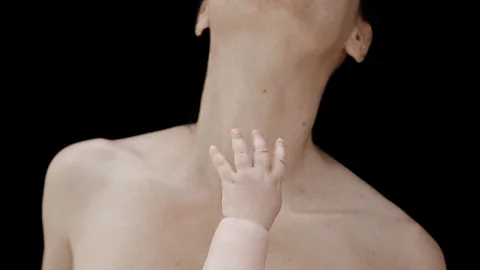 Sophie Ebrard
Sophie EbrardFor International Women’s Day, Deborah Nicholls-Lee explores the work of photographers who look beyond clichés, revealing the physical and psychological changes after giving birth.
Motherhood, as a subject worthy of study, has had to fight for its place in art galleries, says the British photographer Jenny Lewis. “People weren’t looking at it as an appropriate topic for art. It was always seen as a bit ‘soft’,” she says. Lewis sought to change that in her 2010-15 project One Day Young, when she photographed 150 women in their homes in East London within 24 hours after the birth of their babies.
The ambitious project, which was published in a book in 2015, was a rallying cry “to break those hierarchies”, she says, and bring the attention back to the mother. Renaissance painters had long made a meme of the adoration of baby Jesus, but the experience of the Madonna was nowhere to be seen. “What I became really aware of was how overlooked normal people are, and the incredible stories people were telling me time and time again,” says Lewis, whose editorial work is often focused on the famous.
 Jenny Lewis
Jenny LewisPerched on the end of their beds with minimal photographic equipment, Lewis found an extraordinary openness in the new mothers. She says: “People don’t have any self-consciousness when they are photographed at that point because they are so overwhelmed with emotion [and] an amazing authentic self comes across.”
In 2016, WaterAid invited Lewis to repeat the project in Malawi, where some of the women faced a six-hour walk home from the birthing centre. Though her subjects for both locations varied in age, ethnicity and background, the universality of the motherhood experience in the first 24 hours was evident. “All of these women, up until this point, have had such different lives, but at this moment, they’re all the same,’’ she says.
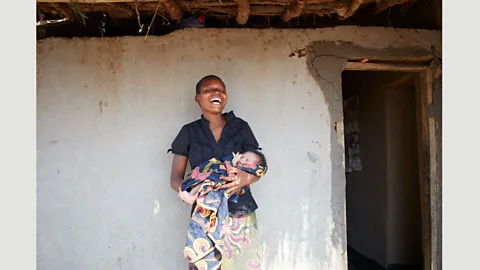 Jenny Lewis
Jenny LewisThe motivation for the project came from Lewis’s own hugely positive experience of becoming a mother, which she felt contrasted with the fear and negativity of most social messaging. “I felt amazing afterwards, so I felt really frustrated that I wasn’t given this seed of confidence from the media, from other people, from conversations. And, visually, there didn’t seem to be that supportive image of motherhood that you could be feeling really empowered,” she says.
A positive side of motherhood
Six-thousand miles away, Taiwanese photographer Annie Hsiao-Ching Wang also had to work hard to get the topic of motherhood the recognition she felt it deserved. When, in 2000, she began formulating what would become the viral The Mother as Creator series, her PhD supervisor advised her that “nobody would care about the personal story of an Asian mother” and that ‘’such a small issue was not worthy of study”, she says. Undeterred, Wang transferred to a different university and pressed on with the project.
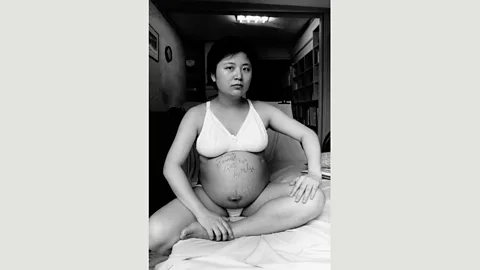 Annie Wang
Annie WangShe began with an honest, unsentimental photograph of herself while pregnant. The following year, she photographed herself with her baby son, Tong, in front of the previous photo. Wang has continued to repeat the process for 19 years now, the previous portraits fading into the distance behind each new one. The photographs, says Wang, are like our memory. “Something a long time ago becomes blurry, almost disappearing. But it is still there in our deepest mind, and we can feel it more or less influencing who we are.”
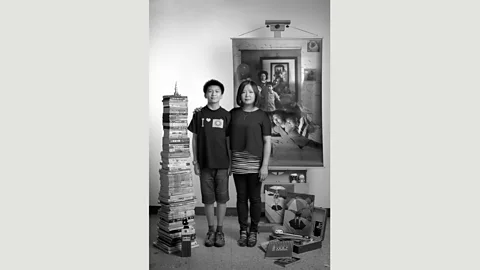 Annie Wang
Annie WangAs well as physical change, Wang’s photographs also document internal struggles. In I sign; I exist, she autographs her pregnant belly to affirm her ownership of her body. “A mother was no longer to be seen as just a ‘container’,” she says.
“My body had been my body for all these years, and to witness it change beyond my control was disturbing,” says French documentary portrait photographer Sophie Ebrard in the confessional audio diary which formed part of her 2019 Amsterdam exhibition, I didn’t want to be a mum. The first of Ebrard’s two pregnancies was unplanned, and matrescence, the process of becoming a mother, proved a difficult transition. “I loved my son, but I didn’t love being a mother,” she says.
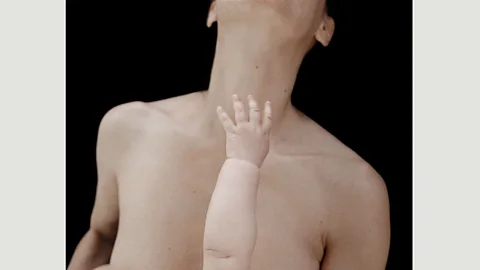 Sophie Ebrard
Sophie EbrardEschewing photography’s tendency to romanticise infancy, from the winged cherubs of Julia Margaret Cameron (1815-79) to cute clickbait on social media, the muscular brute that Ebrard depicts, with its suffocating grip on its mother, makes refreshing but uneasy viewing. Rawer, more confronting pieces, such as the bloody placenta straddled by her feet and a film loop of her stiff, lactating nipple, are an honest window on the less-documented, messy side of motherhood. “I want to educate people on the realities of the experience,” she says, “and create a platform for other people to come forward and express their feelings without guilt or shame.”
Photography through play
In the photo book Kinderwunsch (2013), Mexican photographer Ana Casas Broda communicates her personal journey through fertility treatment, pregnancy and parenthood. Like Ebrard, she seeks a more nuanced representation of motherhood. She says: “I wanted the project to be as complex as the experience of becoming a mother can be – to raise questions, to open up these contradictions about the experience.”
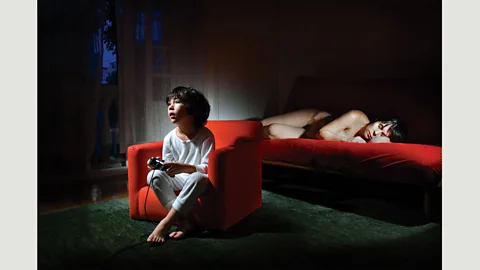 Ana Casas Broda
Ana Casas BrodaMartin, the elder of her two sons, came up with many of the ideas for the shoots, such as wrapping his mother up like an Egyptian mummy. “The games ended up becoming very symbolic and strong images,” says Casas Broda. “The photographs were always a surprise. I set up the lights, we prepared the scenario and then started to play… One image would lead to the other. I couldn’t stop imagining photographs; they would flow in my mind continuously, and come together with my son’s new ideas and the games we would invent.”
For Casas Broda, preserving these intimate moments with her children also caused her to reflect on how she herself was parented. She says: “In some of these images, a painful feeling would also come to the surface, and led me to understand difficult emotions from my own childhood.”
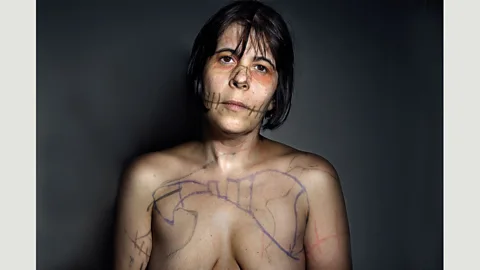 Ana Casas Broda
Ana Casas BrodaPain and imperfection in childhood, as seen through the eyes of the mother, is a prominent theme in the work of American photographer Sally Mann, who trained her lens on her three young children in the controversial photography book Immediate Family (1992). Images of Emmet’s bloody nose, Virginia’s wet bed and Jessie’s face swollen with insect bites offer an unvarnished view of raising children in rural Virginia; while sensual poses, nudity and smoking create a disturbing blur between the world of the adult and the child.
The collision of these two spheres is also poignant in Mary Ellen Mark’s posthumously published Streetwise Revisited (2015), documenting the transition of Erin ‘Tiny’ Brockwell from 13-year-old child prostitute to mother of ten. Mark (1940-2015), who had no children of her own, formed a maternal attachment to the troubled Tiny as she photographed her over 30 years, even offering to bring her from Seattle to New York to live with her.
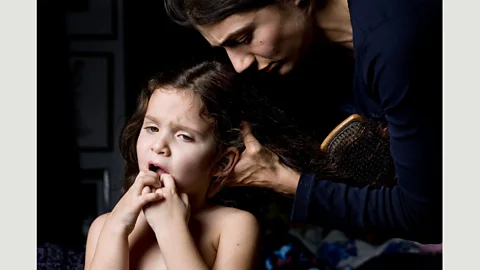 Elinor Carucci
Elinor CarucciFor Israeli-American artist Elinor Carucci, the dynamic was the reverse, as she began her career when still a teenager by photographing her mother – a woman she describes as both “demanding and strict” and “loving and beautiful”. “When I started to take pictures of her, so many things happened. All those qualities that were difficult to deal with became kind of material for work,” she says. “It made me see so much more of her and got our relationship to deeper places.”
In 2013, now a parent of twins, she published Mother, the culmination of 10 years’ work, and a bid for a more authentic depiction of motherhood. She says: “You do have Madonna and child moments, but it’s maybe 0.8% of what it is to be a mother.” Instead, the collection captures the forced intimacy of a child joining her on the toilet or exploring her naked body; and the caesarean scar, linea nigra and engorged breasts of her post-partum body. Can we say that society’s depiction of motherhood is now truthful? “It’s getting there,” she replies.
If you would like to comment on this story or anything else you have seen on BBC Culture, head over to our Facebook page or message us on Twitter.
And if you liked this story, sign up for the weekly bbc.com features newsletter, called The Essential List. A handpicked selection of stories from BBC Future, Culture, Worklife and Travel, delivered to your inbox every Friday.
